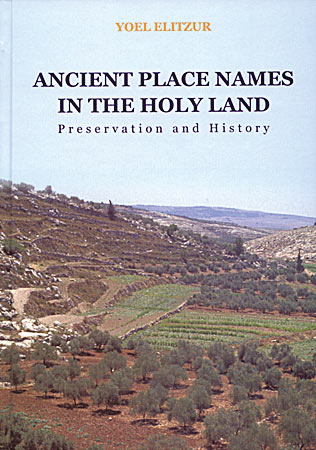Ancient Place Names in the Holy Land
Preservation and History
Yoel Elitzur
That many ancient toponyms in the Holy Land have survived for thousands of years, right up to modern times, is a remarkable and unique phenomenon, unparalleled in neighboring countries, such as Egypt, Mesopotamia, or Asia Minor. Preserved toponymy provides a basis for research in the historical geography of the country and is also of major importance for studies in the history of Hebrew and Aramaic, being a kind of ancient “recording” of an archaic linguistic inventory. In addition, it has many implications for a wide variety of other scholarly fields, such as Bible studies, Rabbinics, Qumran and Samaritan studies, early Christianity, Arabic and Islam. This reserve of preserved place-names is therefore frequently consulted and used by scholars for their purposes. Surprisingly, however, despite the importance of this subject, there have been very few attempts to “put things in order,” and for many years there have been no rules that would help to understand the changes that occur in toponyms. Accordingly, the prevailing situation in the field of historical geography is one of near-anarchy; lacking hard and fast rules, scholars could find support for their identification of an ancient toponym in any somewhat similar Arabic name. In order to break this vicious circle of conjectures founded on dubious linguistic assumptions, producing “preservation laws” themselves provide an alleged basis for historical identification, and so on, Elitzur has tried, first and foremost, to lay down objective criteria for the selection of positive identifications. On this basis, he has built up a corpus of 177 toponyms representing positive or almost-positive identifications, upon which this study is based. Sixty of these toponyms are then reviewed in depth, tracing their documentation in all languages, throughout recorded history; in the process, the author has tried to locate and analyze whatever changes occurred and when. The linguistic conclusions from the material follow, arranged according to the standard layout of grammar books. Innovative conclusions and ideas in the context of historical geography emerged in the course of the study are listed alphabetically in the last part of the volume.
- Description
- Table of Contents
That many ancient toponyms in the Holy Land have survived for thousands of years, right up to modern times, is a remarkable and unique phenomenon, unparalleled in neighboring countries, such as Egypt, Mesopotamia, or Asia Minor. Preserved toponymy provides a basis for research in the historical geography of the country and is also of major importance for studies in the history of Hebrew and Aramaic, being a kind of ancient “recording” of an archaic linguistic inventory. In addition, it has many implications for a wide variety of other scholarly fields, such as Bible studies, Rabbinics, Qumran and Samaritan studies, early Christianity, Arabic and Islam. This reserve of preserved place-names is therefore frequently consulted and used by scholars for their purposes. Surprisingly, however, despite the importance of this subject, there have been very few attempts to “put things in order,” and for many years there have been no rules that would help to understand the changes that occur in toponyms. Accordingly, the prevailing situation in the field of historical geography is one of near-anarchy; lacking hard and fast rules, scholars could find support for their identification of an ancient toponym in any somewhat similar Arabic name. In order to break this vicious circle of conjectures founded on dubious linguistic assumptions, producing “preservation laws” themselves provide an alleged basis for historical identification, and so on, Elitzur has tried, first and foremost, to lay down objective criteria for the selection of positive identifications. On this basis, he has built up a corpus of 177 toponyms representing positive or almost-positive identifications, upon which this study is based. Sixty of these toponyms are then reviewed in depth, tracing their documentation in all languages, throughout recorded history; in the process, the author has tried to locate and analyze whatever changes occurred and when. The linguistic conclusions from the material follow, arranged according to the standard layout of grammar books. Innovative conclusions and ideas in the context of historical geography emerged in the course of the study are listed alphabetically in the last part of the volume.
Preface
Part One: Introduction
Part Two: The Sixty Entries
Part Three: Linguistic Summary
I. Comments on Spelling
II. Phonology
III. Morphology
IV. Definite Article and Syntax
V. Etymology and Semantics
VI. Historical Matters, Transmission of Hebrew
Confluence of Languages
Part Four: New Approaches and Clarifications in
Historical Geography
Bibliography and Abbreviations
Index of Sources
General Index
Linguistic Index
Geographical Name Index
Index of Scholars and Travellers
Word Index
Mailing List
Subscribe to our mailing list and be notified about new titles, journals and catalogs.




